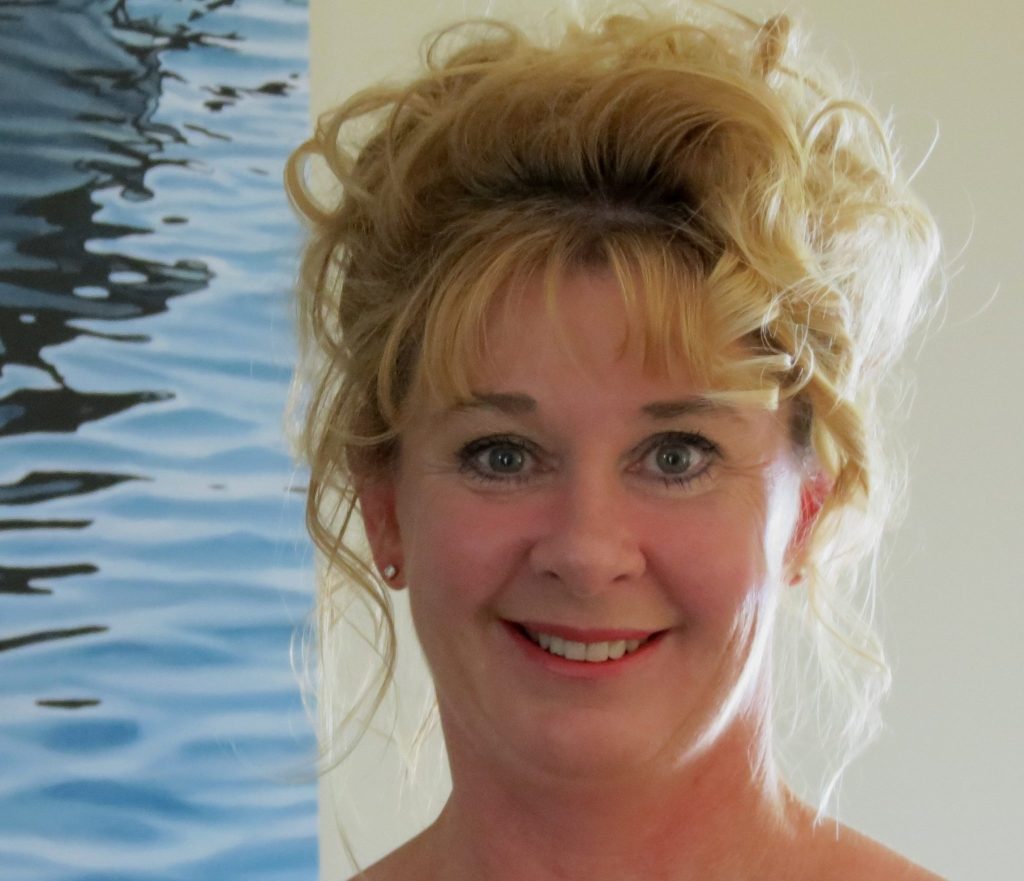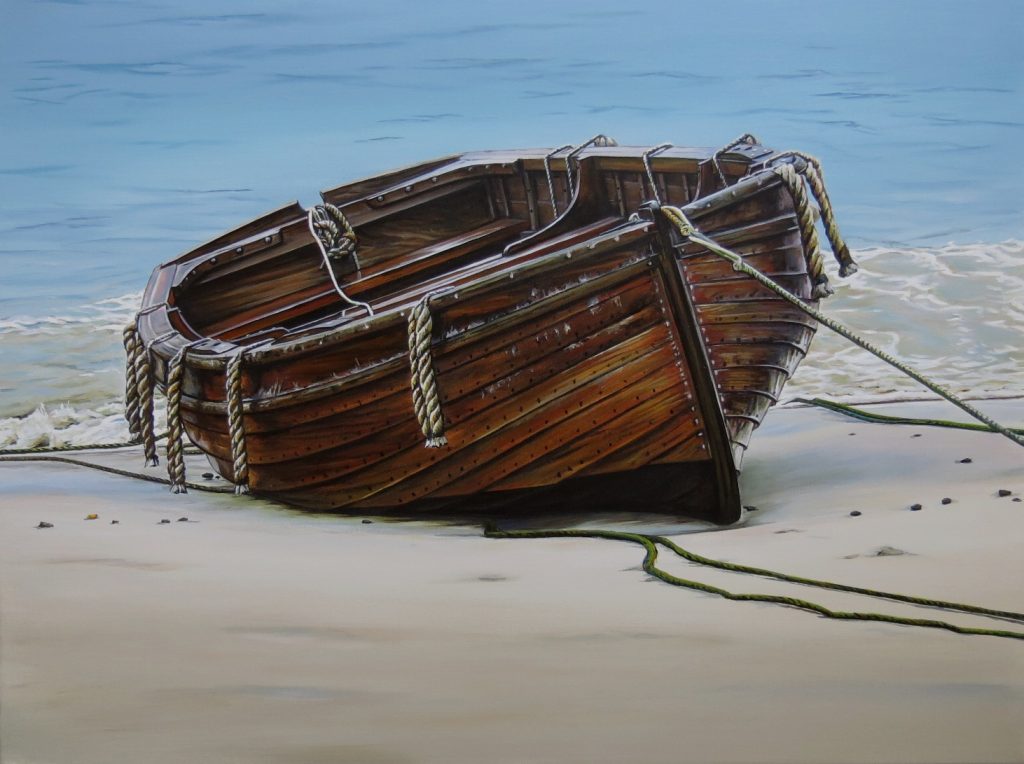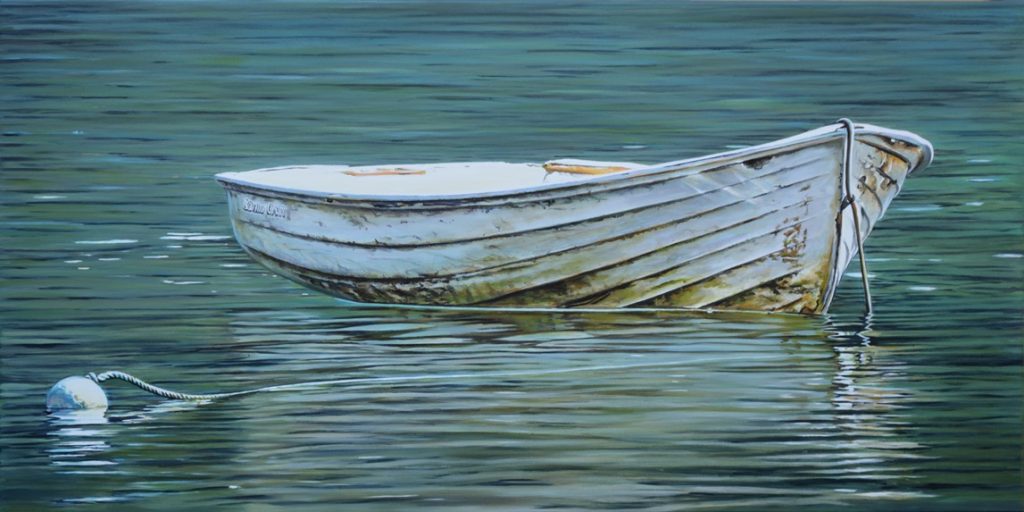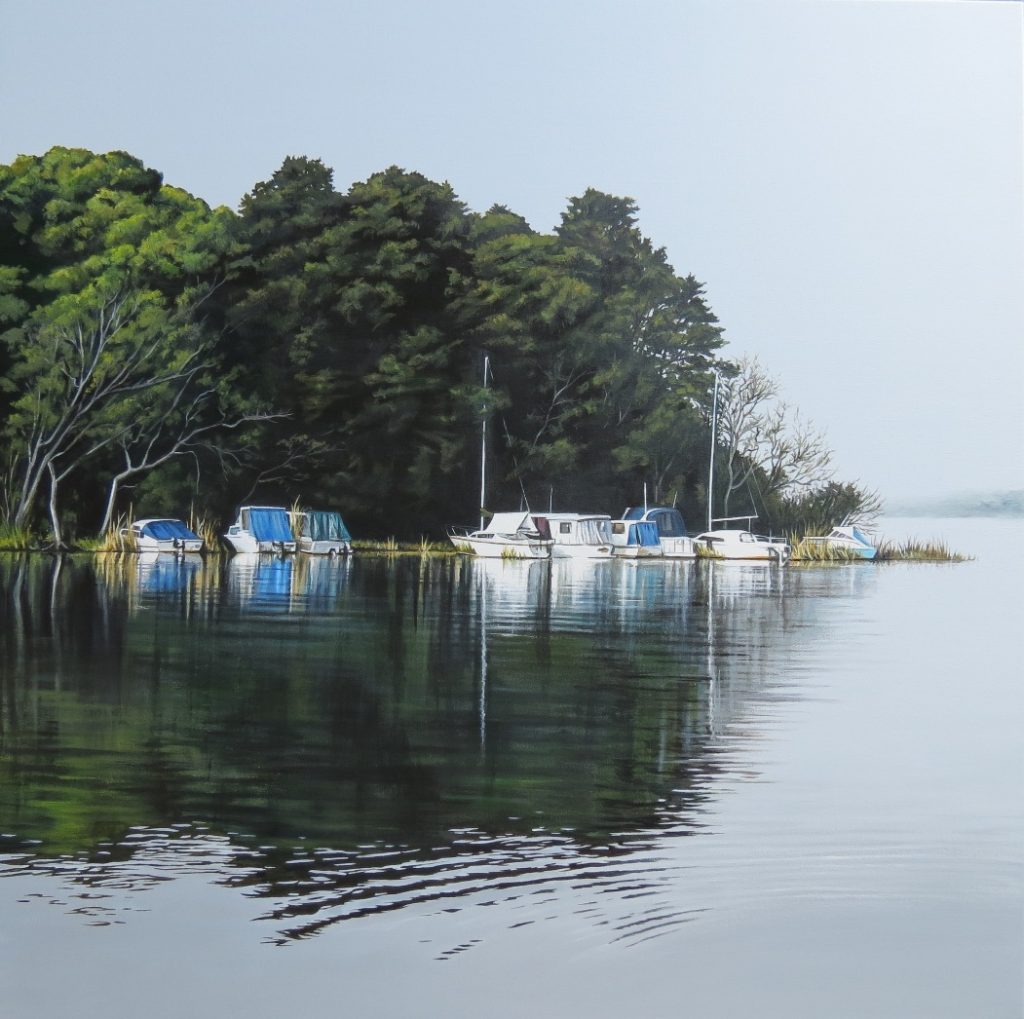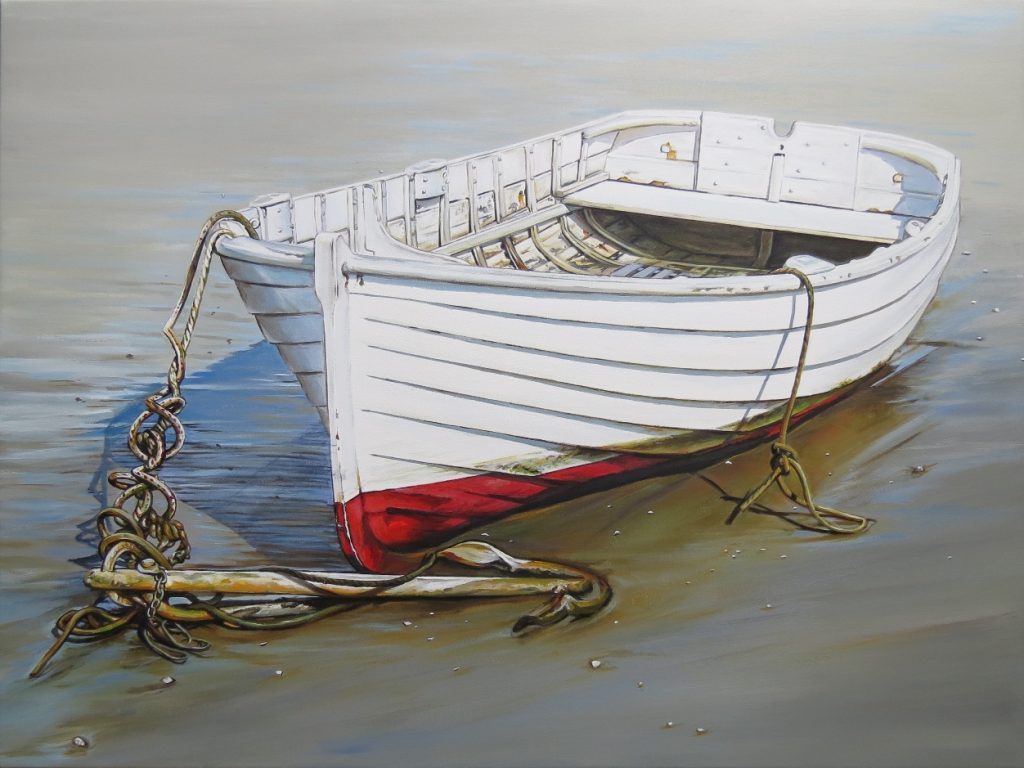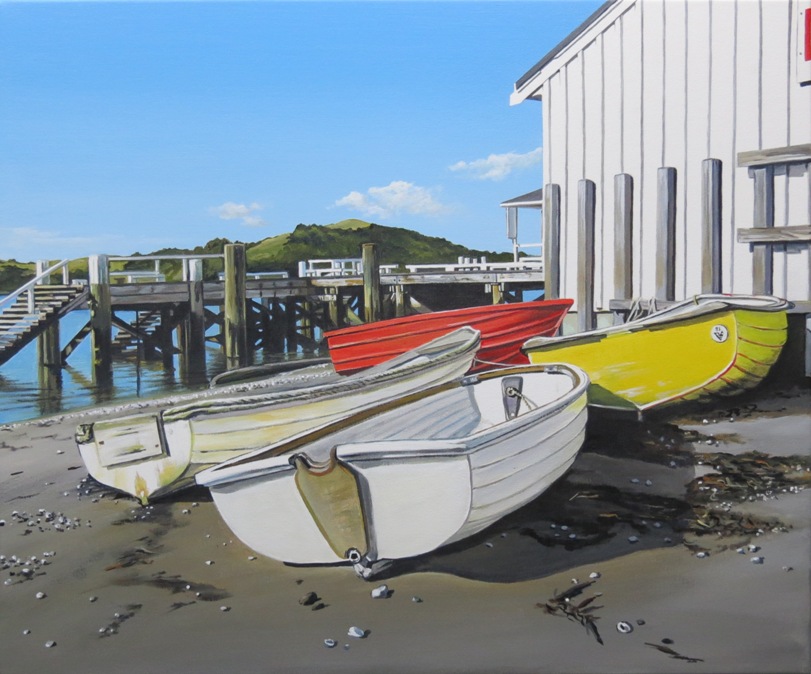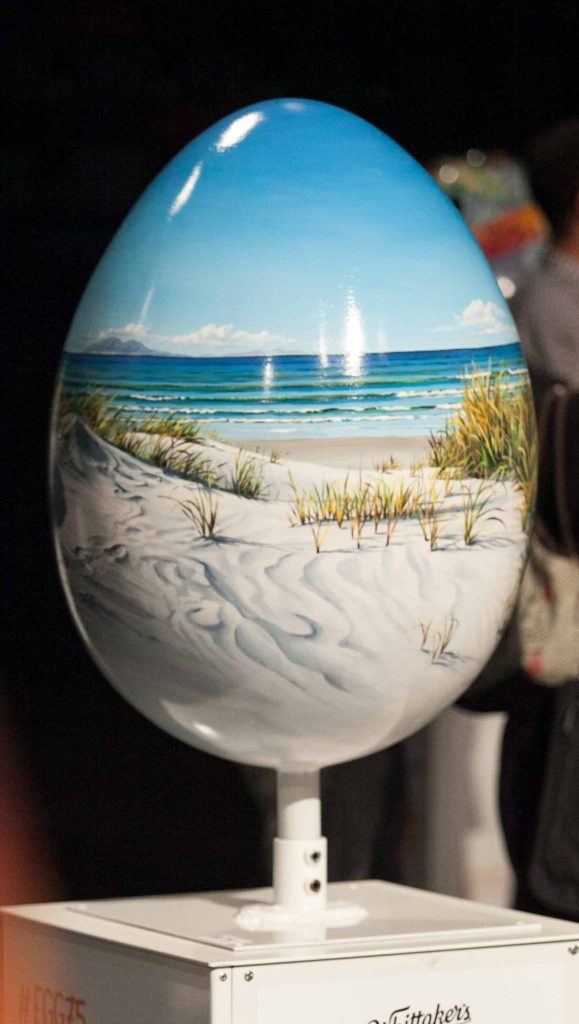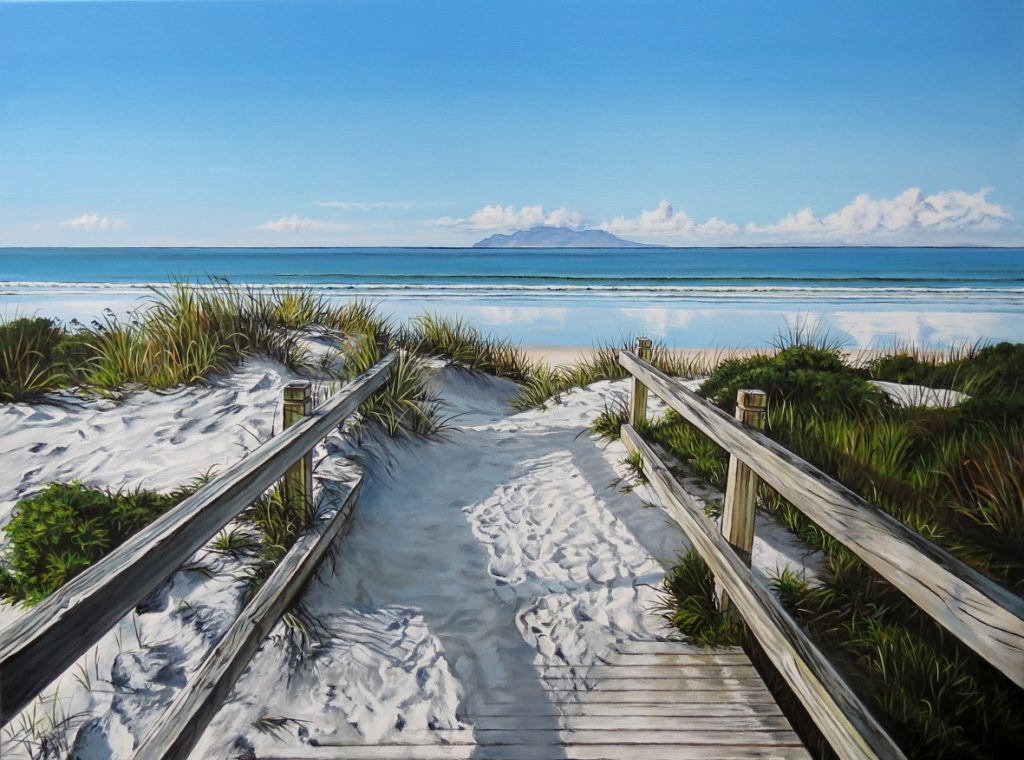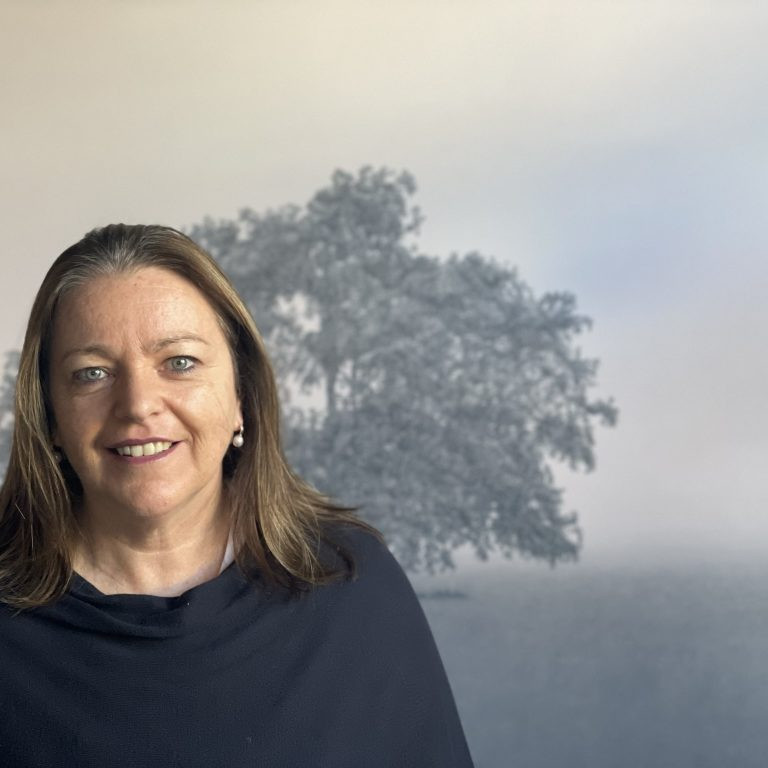Shirley Cresswell Painter - Hamilton, NZ
Discuss ‘Dinghies’ and why they inspire your art so much?
I have spent my life from an early age going to the beach…. Algies Bay north of Auckland,NZ. The first boat I can remember being in was my father’s fishing dinghy. As children we also had a small green dinghy in which I learnt to row and had many hours of fun in. Progressing to small sailing yachts and then to fizz boats. To this day I still spend a lot of time on the water with the family fishing or enjoying water-sports.
To me a dinghy or boat tells a story, an adventure or two. Lots of fun family times. It is hard to find old wooden dinghies these days, as many are fibreglass and plstic or aluminium. The classic old wooden dinghy is becoming a thing of the past. A piece of craftsmanship in their own right and a thing of beauty. I love to see the cracked paint, old ropes and the simple beauty of the water reflections or sand surrounding the boats.
A Story to Tell, 76 x 101cm, Acrylic on boxed canvas
I try to interpret them to be the main focus of the painting, accentuating shadows which gives the boat depth and a 3Dimensional effect.
Describe the technique you use in acrylics to capture your realism on canvas?
I use mostly Atelier Interactive acrylic paints, Golden heavy body and Golden liquid.
I use a wet palette. This I find invaluable as my colours stay usable for a couple of days while working on a large painting. I also use plain old water and recently Pebeo medium to keep my paints wet.
To capture realism it is important for me to choose the right subject that suits my style. Realism results in using clear lines, perfect perspective and use of light and dark to create shadows.
A painting such as a beach scene I always start with the sky and work my way down the painting. The colours I use in the sky I also use in the water. This creates a natural and real scene. I try not to over colour my work and this also helps keep my paintings more real I think.
I apply many layers working from dark to light to achieve a finished result.
Solitude, 61 x 121cm, Acrylic on boxed canvas
Discuss place in relationship to your work? (perhaps using Boatshed Bay)
All my paintings are from places I have been. Often on a day out with my family boating. Boatshed Bay is a beautiful painting which I did from a photo I took before heading out on Lake Tarawera (Rotorua) for a picnic. At the time it was early morning and there was a sea fog down low onto the water. I decided to keep the grey look to the sky, accentuating the trees and the boats nestled amongst them.
Boatshed Bay 91 x 91cm, Acrylic on boxed canvas
So many of your paintings take in the ‘edge’ The boardwalk, Nagapipi Boat Sheds the Dunes, discuss?
I suppose many of my paintings take in the “edge” between land and sea. I love the effect of water and how a scene can lead you into a painting. The feeling that you can walk down the pathway into the painting I have created. Or look across the water to the boatsheds in the distance.
Ngapipi Boat Sheds 24 x 120cm, Acrylic on boxed canvas
How do you work? Plein Air, from photographs, sketchbooks and studio?
I work from my studio at our home in Hamilton. My husband and I spend many hours walking down beach pathways or scouting for old boats and jetties. Then we take hundreds of photos which I then spend time cropping and deciding if there is a painting that I can see in them that would suit my style and give that real effect.
Anchored, 76 x 101cm, Acrylic on boxed canvas
Expand on your subtle use of colour in your work? (Red and Yellow. Anchored)
I like to use subtle colours and keep the painting real. Often keeping a fairly limited palette. Then as in anchored I might bring in a brighter colour into the ropes. I spend many a time just looking at the sky and thinking about what colours I see. To paint real often you need to just look at the colours in the photo and not think about what you are looking at. This means you paint what you actually see without confusing yourself with the fact that it is a boat etc. I used to print my photo reference onto a piece of paper A3 size. This helped to create the correct colour paleete as I could then use a piece of white paper to line up next to my picture to check what colours I should be using. These days I am fortunate to just see colours and have the freedom and confidence to apply them and not worry if I have them perfect.
Red and Yellow, 51 x 91cm, Acrylic on boxed canvas
I try and tie a certain colour into various parts of the painting. AS mentioned the sky colours into the sea and also often the shadows in the sand.
Discuss your Egg work – Dune Eggcursion.
Inspiration: I was challenged to try and create a scene around a 3 dimensional egg that also incorporated my style and look for a fundraising event for our national childrens hospital called The Whittakers Big Egg Hunt. My inspiration was our beautiful beaches in NZ. I decided to keep my horizon going around the whole egg and have to beach scens that merged into the next. I decided to do one of the scenes a sand dune walkway that took you into the scene and the other a beach scene where you looked across the dunes to the ocean. This incorporated the 2 types of beach scenes forms that I do. Each was a different beach with One being Omaha Beach, North Auckland looking out to Little Barrier. The other Waihi Beach looking towards Mayor Island in the Coromandel. I envisioned that the egg could be on a motorised stand and be rotating to see both scenes.
Technique:
The egg was supplied by the event organisers and was made out of fibreglass. I then undercoated it and lightly sanded the egg. MY paints were supplied by Resene Paints, just normal house paints. This was a challenge for me as they were a different consistency to my normal paints. I still used a wet palette with them but it wasn’t as effective as usual. Like all of my paintings I painted on my plan outline and tried to tie in the 2 scenes together using grasses to join. I worked from the top down sky, sea and then the sand and grasses.
This egg was designed to be displayed inside or outside due to using the Resene paints. So once finished and cured I took it to a car painter friend of ours who lacquered it so it was finished with a lovely gloss shine.
Social impact of the work:
The finished egg looked amazing. The response incredible. The egg raised over $5000 for Starship Hospital which was wonderful. People from NZ and all over the world enjoyed seeing the scene made so much more incredible as you could walk around it and enjoy it from every angle. It was just a feel good painting that celebrated our beautiful beached and way of life in NZ.
Will there be more or a similar idea?
Since painting this egg I have thought about what I could do the next time I am asked to create one. I believe the next big egg hunt will be 2017. Exciting and a challenge to come up with a new idea in the future.
Explain the process you take to extend your work to limited edition prints.
As a painting takes a couple of weeks from start to finish I decided to introduce quality prints of my work. It is a bit of a process to decide what sort of prints and find a quality printer. It is important to find someone you can work with as there is a lot of going backwards and forward to get colours correct. All of my work is professionally photographed and matched to the original painting prior to being signed and varnished. The large image of the painting is then sent to the printer to produce the print. I only have a selection of prints available at anytime.
The Board Walk, 76 x 101cm, Acrylic on boxed canvas
It is important to keep accurate documentation and have a fail safe numbering system to keep track of them. I keep a journal with a picture of the painting, the year painted and then numbering. For each print I then document which gallery it is at, or if it has sold etc. I have 3 types of prints. Small canvas prints, archival large canvas prints and giclee prints on fine art paper that are then framed.
Number to each edition
I keep my editions limited to either 15, 30 and a few that are of 100.
Keeping them small means that there is not a huge amount of them on the market and keeps them special I think.
Quality
For me it was important to ensure that the quality is the best that I could get. I feel that I have achieved this and am thrilled how the prints look so much like my original work.
Size The largest prints I have done to date are 1.2m long. I do keep a varied amount of sizes so that customers have a choice of size,
The Dunes, 61 x 150cm, Acrylic on boxed canvas
The reasons behind your choice of a particular work?
Often a particular print starts off when clients request a print when they see an original. If they are unable to afford the original the print gives them another option of having a piece of my work. I try and have a selection of dinghies and beach scenes available. Also prints that have been incredibly time consuming detailed pieces such as Ngapipi Road Boatsheds.
Contact details.www.shirleycresswell.com
www.facebook.com/ShirleyCresswellArtist
Shirley Cresswell, Hamilton, NZ
Interview by Deborah Blakeley, Febuary, 2016
Think a colleague or friend could benefit from this interview?
Knowledge is one of the biggest assets in any business. So why not forward this on to your friends and colleagues so they too can start taking advantage of the insightful information the artist has given?
Other artists you may be interested in:


